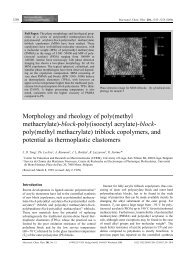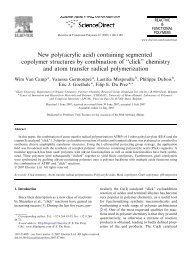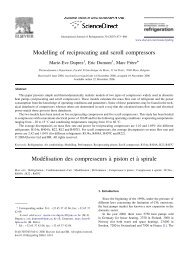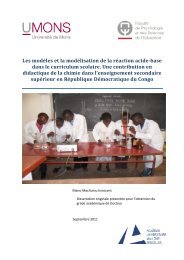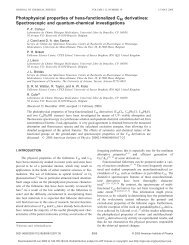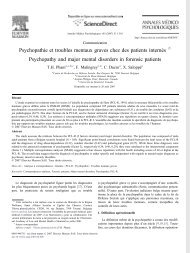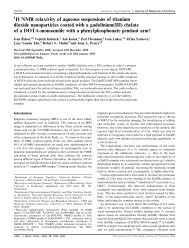Definitive characterization of some C5H5N and C radical cations by ...
Definitive characterization of some C5H5N and C radical cations by ...
Definitive characterization of some C5H5N and C radical cations by ...
Create successful ePaper yourself
Turn your PDF publications into a flip-book with our unique Google optimized e-Paper software.
100 P. Gerbaux et al./International Journal <strong>of</strong> Mass Spectrometry 206 (2001) 91–103<br />
Fig. 5. Ion–molecule reactions between 2b <strong>radical</strong> <strong>cations</strong> (m/z<br />
93) <strong>and</strong> isopropyl iodide: mass spectrum <strong>of</strong> the ions produced in the<br />
quadrupole collision cell.<br />
pyridine N-selenide [3h]. In the same vein, the CH 2<br />
<br />
transfer observed in the reaction <strong>of</strong> the CH 3 CNCH 2<br />
<br />
ion with pyridine-d 5 characterizes its distonic nature<br />
[3g]. As expected with the four i<strong>some</strong>ric ions in the<br />
present study, only the N-methylene pyridine ions<br />
2a show a CH 2 transfer to pyridine-d 5 .<br />
4.6. Ion–molecule reactions with dimethyl disulfide<br />
Analogous to the pyridine case, the 2-picoline<br />
molecular ions react predominantly <strong>by</strong> charge exchange<br />
(m/z 94, 11%). This is not surprising as the<br />
ionization energy <strong>of</strong> 2-picoline (8.6 eV) is higher than<br />
that <strong>of</strong> the disulfide (8.0 eV). The charge exchange<br />
reaction is also observed when the reacting ions have<br />
the structure 2c , but no m/z 94 <strong>radical</strong> <strong>cations</strong> are<br />
detected with 2a <strong>and</strong> 2b . This can be attributed to<br />
the low IEs <strong>of</strong> the corresponding neutrals, 6.1 <strong>and</strong> 6.3<br />
eV, respectively, as derived from the theoretical<br />
calculations <strong>of</strong> Lavorato et al. [7b].<br />
A common reaction product <strong>of</strong> 2a , 2b <strong>and</strong> 2c <br />
is the adduct ion resulting from the expected CH 3 S <br />
<strong>radical</strong> abstraction, characteristic <strong>of</strong> distonic ions, see<br />
Scheme 7. The structures <strong>of</strong> these ions were investigated<br />
<strong>by</strong> consecutive CID experiments. The CID<br />
spectrum <strong>of</strong> the [2aCH 3 S ] ions is shown in Fig.<br />
6(a) <strong>and</strong> is characteristic <strong>of</strong> the proposed structure,<br />
3a (Scheme 7). Peaks at m/z 125 (loss <strong>of</strong> CH 3 ), m/z<br />
93 (loss <strong>of</strong> CH 3 S ) <strong>and</strong> m/z 61 (CH 3 SCH 2 , loss <strong>of</strong><br />
Scheme 7.<br />
pyridine) are indeed in keeping with the 3a structure.<br />
The CID spectrum <strong>of</strong> the adduct ions derived<br />
from 2b is very different, see Fig. 6(b). The m/z 92<br />
base peak in this spectrum corresponds to the loss <strong>of</strong><br />
methanethiol, which is a negligible fragmentation for<br />
ions 3a . The absence <strong>of</strong> the signal at m/z 61<br />
(CH 3 SCH 2 ) is entirely compatible with the proposal<br />
that the sampled ions possess the 3b structure, see<br />
Scheme 7. The production <strong>of</strong> CH 3 SCH 2 ions from<br />
3b would involve the energetically unfavourable<br />
elimination <strong>of</strong> the carbenic pyridine i<strong>some</strong>r 1a. This<br />
neutral, the so-called Hammick intermediate [7a], is<br />
210 kJ/mol higher in energy than its pyridine counterpart.<br />
If the ions prepared from methyl-2-pyridinethiocarboxylate<br />
ions are indeed distonic ions 2c ,itis<br />
expected that abstraction <strong>of</strong> a methylthio <strong>radical</strong><br />
produces ions 3c , N-methyl-2-methylthiopyridine<br />
ions, see Scheme 7. The CID spectrum <strong>of</strong> this ion, see<br />
Fig. 6(c), is different from that <strong>of</strong> 3a <strong>and</strong> 3b .Itis<br />
characterized <strong>by</strong> very intense signals at m/z 125 <strong>and</strong><br />
.<br />
m/z 93 corresponding to the losses <strong>of</strong> CH 3 <strong>and</strong> CH 3 S . ,<br />
respectively. The latter decomposition regenerates the<br />
initial distonic ion 2c . Further, the CID spectrum <strong>of</strong><br />
[2cCH 3 S ] is virtually identical with that obtained<br />
on methylated 2-methylthiopyridine ions generated <strong>by</strong><br />
the methylation <strong>of</strong> N-methyl-2-pyridine-thione [36],<br />
see Scheme 7, <strong>and</strong> this confirms the structure assignment.



